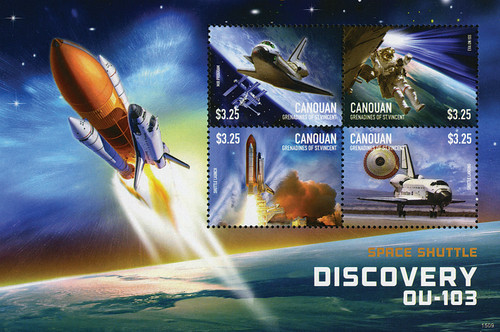
# M11489 - 2015 $3.25 MIR Program
Relive Highlights from Discovery’s Missions to Space
Now you can own a dramatic mint stamp sheet capturing important moments from the space shuttle Discovery’s 39 missions to space. Discovery made more spaceflights than any other spacecraft to date!
Discovery was named after four historic ships captained by Captain James Cook, Henry Hudson, George Nares, and Robert Falcon Scott. Construction on Discovery began in 1980 and its launch was delayed a few times, but it finally took flight at 8:41 a.m. on August 30, 1984.
The third of five US space shuttles built; Discovery was carrying the largest payload up to that time: 41,184 pounds. Most of the payload consisted of three commercial communications satellites, one for Satellite Business Systems, one for Telesat of Canada, and one for the US Navy. Discovery also carried the OAST-1 solar array, which was the largest structure ever extended from a manned spacecraft. There was also a Continuous Flow Electrophoresis System (CFES) experiment with living cells and an experiment in crystal growth in microgravity. After six days, 56 minutes, and four seconds, Discovery returned to Earth on September 5, 1984. It had traveled 2.49 million miles and orbited the earth 97 times.
Over the next 27 years, Discovery launched another 38 times, more than any other spacecraft to date. In that time, Discovery was used as a Return to Flight orbiter following the Challenger and Columbia disasters. It has also launched the Hubble Telescope three times. Other missions have included research and International Space Station assembly. And in 1990, Discovery was used to launch the Ulysses spacecraft, which was sent to explore the sun’s polar regions. Then in 1998, Discovery carried John Glenn back to space 36 years after he became the first American to orbit Earth. On that mission, he became the oldest person to go to space.
In all, Discovery completed 5,830 orbits and spent 365 days in orbit. This made the spacecraft the orbiter flight leader, as it flew more flights than any other orbiter in its fleet. In March 2011, Discovery became the first operational shuttle to be retired. The next year, it was sent to the Smithsonian’s National Air and Space Museum in Washington, DC where it was placed on permanent display.
You can add all the history of the Discovery to your collection – order your mint sheet now.
Relive Highlights from Discovery’s Missions to Space
Now you can own a dramatic mint stamp sheet capturing important moments from the space shuttle Discovery’s 39 missions to space. Discovery made more spaceflights than any other spacecraft to date!
Discovery was named after four historic ships captained by Captain James Cook, Henry Hudson, George Nares, and Robert Falcon Scott. Construction on Discovery began in 1980 and its launch was delayed a few times, but it finally took flight at 8:41 a.m. on August 30, 1984.
The third of five US space shuttles built; Discovery was carrying the largest payload up to that time: 41,184 pounds. Most of the payload consisted of three commercial communications satellites, one for Satellite Business Systems, one for Telesat of Canada, and one for the US Navy. Discovery also carried the OAST-1 solar array, which was the largest structure ever extended from a manned spacecraft. There was also a Continuous Flow Electrophoresis System (CFES) experiment with living cells and an experiment in crystal growth in microgravity. After six days, 56 minutes, and four seconds, Discovery returned to Earth on September 5, 1984. It had traveled 2.49 million miles and orbited the earth 97 times.
Over the next 27 years, Discovery launched another 38 times, more than any other spacecraft to date. In that time, Discovery was used as a Return to Flight orbiter following the Challenger and Columbia disasters. It has also launched the Hubble Telescope three times. Other missions have included research and International Space Station assembly. And in 1990, Discovery was used to launch the Ulysses spacecraft, which was sent to explore the sun’s polar regions. Then in 1998, Discovery carried John Glenn back to space 36 years after he became the first American to orbit Earth. On that mission, he became the oldest person to go to space.
In all, Discovery completed 5,830 orbits and spent 365 days in orbit. This made the spacecraft the orbiter flight leader, as it flew more flights than any other orbiter in its fleet. In March 2011, Discovery became the first operational shuttle to be retired. The next year, it was sent to the Smithsonian’s National Air and Space Museum in Washington, DC where it was placed on permanent display.
You can add all the history of the Discovery to your collection – order your mint sheet now.











